Presentation(malak eshtawi)
Download as pptx, pdf0 likes226 views
This is a student talk presented as part of a Knowledge Engineering course summarizing a synthesis paper on bioinformatics and protein ontologies. The talk introduces the protein phosphatase family and discusses the development of a phosphatase ontology to classify protein sequences. It then describes the materials and methods used for bioinformatics analysis of protein phosphatases, including extracting phosphatase gene products, performing domain analysis, and identifying class membership. Finally, it discusses translating the ontology into OWL and loading protein instances to systematically classify proteins into phosphatase classes.
1 of 9
Download to read offline
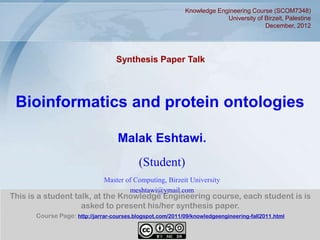
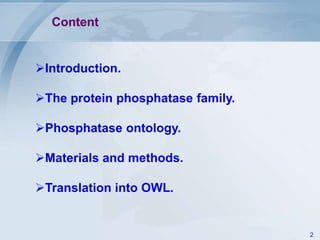
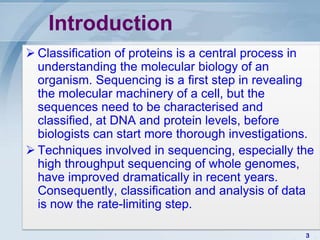
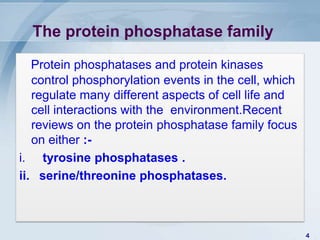

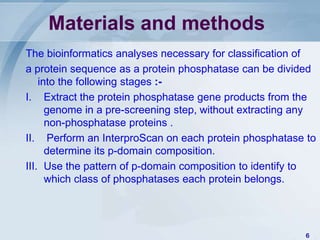

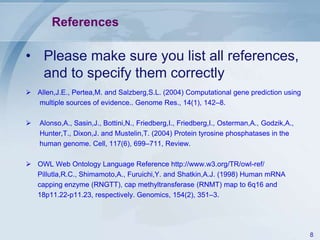

Ad
Recommended
Jessica Arama-CV-final
Jessica Arama-CV-finaljessica arama
╠²
This document provides a summary of Jessica Arama's education, laboratory experience, and publications. She holds a PhD from UCL investigating the role of GABAA receptor subunits in synapse formation. Her laboratory experience includes projects studying GABAergic synapses, astrocytic connexins, and the molecular basis of neuromuscular junction formation. She has published papers on the role of GABAA receptors in inhibitory synapse development and the effects of Bmcc1s on cell morphology.The in vitro choice ellen iuf 2013
The in vitro choice ellen iuf 2013La unidad de Toxicolog├Ła Experimental y Ecotoxicolog├Ła (UTOX-PCB)
╠²
This document describes the use of 3D neurosphere assays to study developmental neurotoxicity. Neural stem/progenitor cells from fetal rat and human brains are cultured as neurospheres to model processes of brain development in vitro. The neurosphere assay can assess effects of compounds on proliferation, migration, differentiation and other pathways. It allows medium-throughput testing of compounds using automated imaging and analysis. Species-specific effects of compounds like valproic acid on rat and human neurospheres have been observed. The neurosphere assay is useful for safety testing and drug development by providing a 3D in vitro model of the developing brain.Evolved not engineered: a systems neurobiology
Evolved not engineered: a systems neurobiologyBj├Črn Brembs
╠²
The document discusses how biological systems evolve complex gene interactions and networks in response to environmental pressures, rather than being engineered like machines, using examples from neuroscience research on fruit flies, squid, and fish to illustrate how neural systems respond to stimuli in variable and adaptive ways. It also examines theories of how biological systems achieve robustness through degeneracy and maintain behavioral variability through multiple learning systems that balance exploitation and exploration.SELF ASSEMBLY OF IONIC COMPLEMENTARY PEPTIDES & THEIR APPLICATIONS IN NANO-BI...
SELF ASSEMBLY OF IONIC COMPLEMENTARY PEPTIDES & THEIR APPLICATIONS IN NANO-BI...RIJU CHANDRAN.R
╠²
This document discusses molecular self-assembly using ionic-complementary peptides and their applications in nanobiotechnology. It introduces molecular self-assembly, noting that peptides can be engineered to form stable nanostructures through non-covalent interactions. A specific ionic-complementary peptide, EAK16-II, is discussed as a model for studying peptide assembly. Several factors that can influence peptide self-assembly are also outlined, including amino acid sequence, pH, salt concentration, and time. Finally, potential applications of ionic-complementary peptides are presented, including nanofabrication, biosensing, studying protein conformational diseases, tissue engineering, and drug delivery.praveena_CV_17012016
praveena_CV_17012016Praveena Ramanujam
╠²
R L Praveena has a Ph.D from the Indian Institute of Science Education and Research and expertise in cloning, protein purification, and the Wnt/Wg signaling pathway using fly models. She has strong backgrounds in molecular biology and cell biology and experience using various biotechnology tools and techniques. Her thesis involved screening for interacting partners of the genome organizer SATB1 and establishing its physical interaction with and regulation of the Wnt/Wg pathway through experiments including mammalian two-hybrid assays, reporter assays, pulldowns, and quantitative RT-PCR.Darwin
Darwinuniversity of education,Lahore
╠²
This document discusses various techniques for analyzing nucleotide and peptide sequences, including sequence alignment, searches of biological databases, and identifying intrinsic features, point mutations, and genetic diversity. It also describes sequence assembly, which involves reconstructing DNA sequences by aligning and merging small fragments from sequencing. Additionally, it discusses gene prediction to identify genomic regions that encode genes and protein structure prediction using statistical analysis of amino acid residues and inference from related proteins with known structures.Berlin center for genome based bioinformatics koch05
Berlin center for genome based bioinformatics koch05Slava Karpov
╠²
This document summarizes the research activities of the Berlin Center for Genome Based Bioinformatics at the Technical University of Applied Sciences. The center focuses on modeling and analyzing biochemical systems using Petri nets. Specifically, it has modeled central metabolic pathways like glycolysis and developed Petri net tools to validate biochemical networks and analyze the behavior of large networks like E. coli metabolism.Genome annotation 2013
Genome annotation 2013Karan Veer Singh
╠²
The document discusses genome annotation, covering its significance in biological understanding and the methodologies involved, including structural and functional genomics. It details the history and development of genome annotation techniques, highlighting the Human Genome Project and various gene-finding algorithms used for genomic analysis. The text emphasizes the importance of accurate annotation and the continuous evolution of gene predictions and functional assignments as new data emerges.Kihara Bioinformatics Lab Research Summary 2016
Kihara Bioinformatics Lab Research Summary 2016Purdue University
╠²
The document describes research from the Kihara Lab at Purdue University on bioinformatics and computational biology topics, including PL-PatchSurfer2 which is a virtual screening method that performs better than existing methods at predicting ligand binding, particularly on computationally modeled protein structures. It also describes research on predicting protein function, detecting moonlighting proteins, and modeling protein folding as an information theoretic noisy channel.Protein function and bioinformatics
Protein function and bioinformaticsNeil Saunders
╠²
This document outlines a talk on protein function and bioinformatics. It discusses why bioinformatics is needed due to the rapid increase in genomic data. It introduces various bioinformatics tools for tasks like sequence analysis, database searches, and structure prediction. As a case study, it examines the genome of the psychrophilic archaeon Methanococcoides burtonii, identifying cold-adaptation features like CSP-like proteins and modified tRNAs. It emphasizes that bioinformatics provides useful predictions but must be integrated with experimental data.Protein structure 2
Protein structure 2Rainu Rajeev
╠²
This document discusses protein structural bioinformatics and methods for predicting protein structure using bioinformatics approaches. It defines protein structural bioinformatics as focusing on representing, storing, analyzing and displaying protein structural information at the atomic scale. It describes how bioinformatics can be used to visualize, align, classify and predict protein structures. It also summarizes several specific methods for predicting protein secondary structure and tertiary structure, including homology modeling, threading and ab initio prediction.Bioalgo 2012-03-massspec
Bioalgo 2012-03-massspecBioinformaticsInstitute
╠²
This document discusses protein identification from mass spectrometry data. It describes how tandem mass spectrometry is used to break proteins into peptides and peptides into fragment ions. The fragment ion masses can then be used to reconstruct the peptide sequence de novo or search protein databases to identify the source protein. Key algorithms discussed include de novo sequencing, database search tools like Sequest and Mascot, and techniques like InsPecT that can rapidly search large databases or analyze many spectra.2015 bioinformatics protein_structure_wimvancriekinge
2015 bioinformatics protein_structure_wimvancriekingeProf. Wim Van Criekinge
╠²
This document discusses different levels of protein structure from primary to quaternary structure. It explains that primary structure refers to the amino acid sequence of a protein. Secondary structure describes local folding patterns like alpha helices and beta sheets. Tertiary structure is the overall 3D shape of a single protein chain that results from folding. Quaternary structure involves the shape and interactions of multiple protein subunits. The document provides examples and diagrams to illustrate each level of structure and how they relate to determining a protein's function.Chemistry of amino acids
Chemistry of amino acidsNamrata Chhabra
╠²
The document provides information about amino acids and their classification. It discusses that amino acids are the monomer units that make up protein polymers. They can be classified based on their structure, side chains, nutritional requirements, and metabolic fate. The 20 standard amino acids are discussed in detail, including their physical and chemical properties. Key reactions of amino acids involving their amino, carboxyl, and side chain groups are also summarized.amino acids
amino acidsAmeenah
╠²
The document discusses amino acids, which are molecules that contain an amine group, a carboxylic acid group, and a side chain. There are 22 standard amino acids that are incorporated into proteins, as well as non-standard amino acids. Amino acids join together to form peptides or longer protein chains. Methods for synthesizing alpha-amino acids include amination reactions, Gabriel synthesis, Strecker synthesis, resolution of racemic mixtures, and the Petasis reaction. Amino acids undergo various reactions including esterification, acylation, and the ninhydrin reaction.Ontology at Manchester
Ontology at Manchesterrobertstevens65
╠²
The document summarizes ontology research at the University of Manchester. It discusses defining ontologies using OWL, applying reasoning to classify proteins and detect missing knowledge, building ontologies collaboratively, and using ontologies to model biology and medicine. The research uses ontologies for tasks like protein classification, semantic search, and guiding data annotation in domains like genomics and healthcare.Using Ontology to Classify Members of a Protein Family
Using Ontology to Classify Members of a Protein Family robertstevens65
╠²
This document discusses using an ontology to automatically classify proteins into families based on their functional domains. It describes building an OWL ontology that defines protein family membership in terms of domains. The ontology allows classifying protein instances by describing them in terms of domains and reasoning about their classification. The system was able to classify proteins as well as human experts and revealed new insights about phosphatase evolution and classification.Free software and bioinformatics
Free software and bioinformaticsAlberto Labarga
╠²
This document discusses the importance of open source software and open data in biomedical research. It notes that biological data is growing exponentially and highlights several open source bioinformatics tools like EMBOSS and web services provided by the EBI that enable researchers to access and analyze data. The document advocates for open standards to facilitate data integration and management across different omics domains.Swat4 ls2012
Swat4 ls2012Nadia Anwar
╠²
The document discusses bespoke data integration using open source and semantic technologies. It describes integrating fly expression and pathway data from FlyAtlas and FlyCyc into linked data triples, then inferring additional triples and visualizing the results in pathways and networks using tools like PathVisio and Cytoscape. The approach emphasizes flexibility by using linked data, common identifiers, and being willing to extend ontologies over time as understanding improves.Ewan Birney Biocuration 2013
Ewan Birney Biocuration 2013Iddo
╠²
Ewan Birney summarizes the types of curation needed in molecular biology. There are five main types: experimental data entry, experimental metadata capture, consensus integration of information, knowledge frameworks, and knowledge management. Curation is critical for biology to integrate and organize the vast amounts of data being generated, but curation work is often overlooked despite its complexity. Large infrastructures are needed to support curation efforts and ensure biological data and knowledge can be reliably accessed and built upon over decades.Lewis isb 7 april2014
Lewis isb 7 april2014Suzanna Lewis
╠²
The document discusses the role of biocurators and standards in biological research. It notes that biocurators are responsible for curating and maintaining biological knowledge bases. The document advocates that biocurators should promote community standards to facilitate collaboration and benchmarking across databases. It provides examples where standards have enabled large-scale projects and the development of shared community resources. The role of biocurators is shifting as publishing changes, and curation will continue to be important for resolving differences, providing clarity and validating automated methods.Lewis isb 7 april2014
Lewis isb 7 april2014Suzanna Lewis
╠²
The document discusses the role of biocurators and standards in biological research. It notes that biocurators are responsible for curating and maintaining biological knowledge bases. The document advocates that biocurators should promote community standards to facilitate collaboration and benchmarking across databases. It provides examples where standards have enabled large-scale projects and the development of shared community resources. The role of biocurators is shifting as publishing changes, and curation will continue to be important for resolving differences, providing clarity and validating automated methods.2013 nas-ehs-data-integration-dc
2013 nas-ehs-data-integration-dcc.titus.brown
╠²
This document discusses challenges and opportunities for integrating large, heterogeneous biological data sets. It outlines the types of analysis and discovery that could be enabled, such as comparing data across studies. Technical challenges include incompatible identifiers and schemas between data sources. Common solutions attempt standardization but have limitations. The document examines Amazon's approach as a model, with principles like exposing all data through programmatic interfaces. It argues for a "platform" approach and combining data-driven and model-driven analysis to gain new insights. Developing services with end users in mind could help maximize data reuse.Protein Structure Alignment and Comparison
Protein Structure Alignment and ComparisonNatalio Krasnogor
╠²
The document presents the procksi-server, an online decision support system designed for protein structure comparison. It discusses the importance of protein structures, existing comparison methods, and introduces procksi's unique approaches, including its home-grown methods like universal similarity metric (USM) and maximum contact map overlap (max-CMO). Finally, it emphasizes the need for a comprehensive platform that integrates various methods and facilitates user-friendly analysis for protein structure researchers.Enriching the Gene Ontology via the Dissection of Labels using the Ontology P...
Enriching the Gene Ontology via the Dissection of Labels using the Ontology P...jesualdofernandez
╠²
The document discusses the enhancement of the Gene Ontology (GO) through the analysis and normalization of ontology labels using the Ontology Pre-Processor Language (OPPL). It describes how specific linguistic patterns and knowledge patterns can aid in ontology enrichment, leading to the creation of new classes and improved querying capabilities. Results show a significant increase in the number of classes and subclass axioms, highlighting the utility of OPPL and the structural knowledge embedded in biomedical ontologies.Pathway analysis 2012
Pathway analysis 2012Stephen Turner
╠²
The document discusses the role of bioinformatics and its core services, specifically focusing on pathway analysis as a key technique for interpreting high-throughput data. It outlines various bioinformatics services provided, including gene expression analysis and DNA variation, and emphasizes the importance of contextualizing gene lists within biological pathways. It also highlights the complexities and limitations of pathway analysis techniques, ultimately suggesting that expert biological knowledge is essential for meaningful interpretation.Different Modes of Data Storage and Phylogenetic Analysis
Different Modes of Data Storage and Phylogenetic AnalysisHarishSharma807212
╠²
The presentation by Harish Sharma discusses data storage and phylogenetic analysis in the context of bioinformatics, highlighting the challenges posed by the exponential growth of biological data. It covers various storage formats, including flat files, relational databases, and NoSQL databases, as well as the methods for constructing phylogenetic trees to analyze evolutionary relationships among organisms. Emphasis is placed on the significance of tools and software used in data handling and phylogenetic analysis to facilitate research in evolutionary biology.Role of bioinformatics in life sciences research
Role of bioinformatics in life sciences researchAnshika Bansal
╠²
1. The document discusses bioinformatics and summarizes some of its key applications and tools. It describes how bioinformatics merges biology and computer science to solve biological problems by applying computational tools to molecular data.
2. It provides examples of common bioinformatics tasks like retrieving sequences from databases, comparing sequences, analyzing genes and proteins, and viewing 3D structures.
3. The document lists several popular databases for nucleotide sequences, protein sequences, literature, and other biological data. It also introduces common bioinformatics tools for tasks like sequence alignment, translation, and structure analysis.Functional Coherence Of Molecular Networks In Bioinformatics 1st Edition Mehm...
Functional Coherence Of Molecular Networks In Bioinformatics 1st Edition Mehm...tesylaseona
╠²
Functional Coherence Of Molecular Networks In Bioinformatics 1st Edition Mehmet Koyutrk
Functional Coherence Of Molecular Networks In Bioinformatics 1st Edition Mehmet Koyutrk
Functional Coherence Of Molecular Networks In Bioinformatics 1st Edition Mehmet KoyutrkBio2RDF and Beyond!
Bio2RDF and Beyond!Michel Dumontier
╠²
The document discusses the challenges of biological knowledge discovery and the need for improved access to vast biological data stored in silos. It introduces bio2rdf as a framework for creating linked data networks, utilizing the Resource Description Framework (RDF) to enable multi-source data integration and sophisticated queries through standards like SPARQL. Additionally, it highlights future steps towards personalized medicine and the role of pharmacogenomics in tailoring drug treatments to individuals.More Related Content
Viewers also liked (7)
Kihara Bioinformatics Lab Research Summary 2016
Kihara Bioinformatics Lab Research Summary 2016Purdue University
╠²
The document describes research from the Kihara Lab at Purdue University on bioinformatics and computational biology topics, including PL-PatchSurfer2 which is a virtual screening method that performs better than existing methods at predicting ligand binding, particularly on computationally modeled protein structures. It also describes research on predicting protein function, detecting moonlighting proteins, and modeling protein folding as an information theoretic noisy channel.Protein function and bioinformatics
Protein function and bioinformaticsNeil Saunders
╠²
This document outlines a talk on protein function and bioinformatics. It discusses why bioinformatics is needed due to the rapid increase in genomic data. It introduces various bioinformatics tools for tasks like sequence analysis, database searches, and structure prediction. As a case study, it examines the genome of the psychrophilic archaeon Methanococcoides burtonii, identifying cold-adaptation features like CSP-like proteins and modified tRNAs. It emphasizes that bioinformatics provides useful predictions but must be integrated with experimental data.Protein structure 2
Protein structure 2Rainu Rajeev
╠²
This document discusses protein structural bioinformatics and methods for predicting protein structure using bioinformatics approaches. It defines protein structural bioinformatics as focusing on representing, storing, analyzing and displaying protein structural information at the atomic scale. It describes how bioinformatics can be used to visualize, align, classify and predict protein structures. It also summarizes several specific methods for predicting protein secondary structure and tertiary structure, including homology modeling, threading and ab initio prediction.Bioalgo 2012-03-massspec
Bioalgo 2012-03-massspecBioinformaticsInstitute
╠²
This document discusses protein identification from mass spectrometry data. It describes how tandem mass spectrometry is used to break proteins into peptides and peptides into fragment ions. The fragment ion masses can then be used to reconstruct the peptide sequence de novo or search protein databases to identify the source protein. Key algorithms discussed include de novo sequencing, database search tools like Sequest and Mascot, and techniques like InsPecT that can rapidly search large databases or analyze many spectra.2015 bioinformatics protein_structure_wimvancriekinge
2015 bioinformatics protein_structure_wimvancriekingeProf. Wim Van Criekinge
╠²
This document discusses different levels of protein structure from primary to quaternary structure. It explains that primary structure refers to the amino acid sequence of a protein. Secondary structure describes local folding patterns like alpha helices and beta sheets. Tertiary structure is the overall 3D shape of a single protein chain that results from folding. Quaternary structure involves the shape and interactions of multiple protein subunits. The document provides examples and diagrams to illustrate each level of structure and how they relate to determining a protein's function.Chemistry of amino acids
Chemistry of amino acidsNamrata Chhabra
╠²
The document provides information about amino acids and their classification. It discusses that amino acids are the monomer units that make up protein polymers. They can be classified based on their structure, side chains, nutritional requirements, and metabolic fate. The 20 standard amino acids are discussed in detail, including their physical and chemical properties. Key reactions of amino acids involving their amino, carboxyl, and side chain groups are also summarized.amino acids
amino acidsAmeenah
╠²
The document discusses amino acids, which are molecules that contain an amine group, a carboxylic acid group, and a side chain. There are 22 standard amino acids that are incorporated into proteins, as well as non-standard amino acids. Amino acids join together to form peptides or longer protein chains. Methods for synthesizing alpha-amino acids include amination reactions, Gabriel synthesis, Strecker synthesis, resolution of racemic mixtures, and the Petasis reaction. Amino acids undergo various reactions including esterification, acylation, and the ninhydrin reaction.Similar to Presentation(malak eshtawi) (20)
Ontology at Manchester
Ontology at Manchesterrobertstevens65
╠²
The document summarizes ontology research at the University of Manchester. It discusses defining ontologies using OWL, applying reasoning to classify proteins and detect missing knowledge, building ontologies collaboratively, and using ontologies to model biology and medicine. The research uses ontologies for tasks like protein classification, semantic search, and guiding data annotation in domains like genomics and healthcare.Using Ontology to Classify Members of a Protein Family
Using Ontology to Classify Members of a Protein Family robertstevens65
╠²
This document discusses using an ontology to automatically classify proteins into families based on their functional domains. It describes building an OWL ontology that defines protein family membership in terms of domains. The ontology allows classifying protein instances by describing them in terms of domains and reasoning about their classification. The system was able to classify proteins as well as human experts and revealed new insights about phosphatase evolution and classification.Free software and bioinformatics
Free software and bioinformaticsAlberto Labarga
╠²
This document discusses the importance of open source software and open data in biomedical research. It notes that biological data is growing exponentially and highlights several open source bioinformatics tools like EMBOSS and web services provided by the EBI that enable researchers to access and analyze data. The document advocates for open standards to facilitate data integration and management across different omics domains.Swat4 ls2012
Swat4 ls2012Nadia Anwar
╠²
The document discusses bespoke data integration using open source and semantic technologies. It describes integrating fly expression and pathway data from FlyAtlas and FlyCyc into linked data triples, then inferring additional triples and visualizing the results in pathways and networks using tools like PathVisio and Cytoscape. The approach emphasizes flexibility by using linked data, common identifiers, and being willing to extend ontologies over time as understanding improves.Ewan Birney Biocuration 2013
Ewan Birney Biocuration 2013Iddo
╠²
Ewan Birney summarizes the types of curation needed in molecular biology. There are five main types: experimental data entry, experimental metadata capture, consensus integration of information, knowledge frameworks, and knowledge management. Curation is critical for biology to integrate and organize the vast amounts of data being generated, but curation work is often overlooked despite its complexity. Large infrastructures are needed to support curation efforts and ensure biological data and knowledge can be reliably accessed and built upon over decades.Lewis isb 7 april2014
Lewis isb 7 april2014Suzanna Lewis
╠²
The document discusses the role of biocurators and standards in biological research. It notes that biocurators are responsible for curating and maintaining biological knowledge bases. The document advocates that biocurators should promote community standards to facilitate collaboration and benchmarking across databases. It provides examples where standards have enabled large-scale projects and the development of shared community resources. The role of biocurators is shifting as publishing changes, and curation will continue to be important for resolving differences, providing clarity and validating automated methods.Lewis isb 7 april2014
Lewis isb 7 april2014Suzanna Lewis
╠²
The document discusses the role of biocurators and standards in biological research. It notes that biocurators are responsible for curating and maintaining biological knowledge bases. The document advocates that biocurators should promote community standards to facilitate collaboration and benchmarking across databases. It provides examples where standards have enabled large-scale projects and the development of shared community resources. The role of biocurators is shifting as publishing changes, and curation will continue to be important for resolving differences, providing clarity and validating automated methods.2013 nas-ehs-data-integration-dc
2013 nas-ehs-data-integration-dcc.titus.brown
╠²
This document discusses challenges and opportunities for integrating large, heterogeneous biological data sets. It outlines the types of analysis and discovery that could be enabled, such as comparing data across studies. Technical challenges include incompatible identifiers and schemas between data sources. Common solutions attempt standardization but have limitations. The document examines Amazon's approach as a model, with principles like exposing all data through programmatic interfaces. It argues for a "platform" approach and combining data-driven and model-driven analysis to gain new insights. Developing services with end users in mind could help maximize data reuse.Protein Structure Alignment and Comparison
Protein Structure Alignment and ComparisonNatalio Krasnogor
╠²
The document presents the procksi-server, an online decision support system designed for protein structure comparison. It discusses the importance of protein structures, existing comparison methods, and introduces procksi's unique approaches, including its home-grown methods like universal similarity metric (USM) and maximum contact map overlap (max-CMO). Finally, it emphasizes the need for a comprehensive platform that integrates various methods and facilitates user-friendly analysis for protein structure researchers.Enriching the Gene Ontology via the Dissection of Labels using the Ontology P...
Enriching the Gene Ontology via the Dissection of Labels using the Ontology P...jesualdofernandez
╠²
The document discusses the enhancement of the Gene Ontology (GO) through the analysis and normalization of ontology labels using the Ontology Pre-Processor Language (OPPL). It describes how specific linguistic patterns and knowledge patterns can aid in ontology enrichment, leading to the creation of new classes and improved querying capabilities. Results show a significant increase in the number of classes and subclass axioms, highlighting the utility of OPPL and the structural knowledge embedded in biomedical ontologies.Pathway analysis 2012
Pathway analysis 2012Stephen Turner
╠²
The document discusses the role of bioinformatics and its core services, specifically focusing on pathway analysis as a key technique for interpreting high-throughput data. It outlines various bioinformatics services provided, including gene expression analysis and DNA variation, and emphasizes the importance of contextualizing gene lists within biological pathways. It also highlights the complexities and limitations of pathway analysis techniques, ultimately suggesting that expert biological knowledge is essential for meaningful interpretation.Different Modes of Data Storage and Phylogenetic Analysis
Different Modes of Data Storage and Phylogenetic AnalysisHarishSharma807212
╠²
The presentation by Harish Sharma discusses data storage and phylogenetic analysis in the context of bioinformatics, highlighting the challenges posed by the exponential growth of biological data. It covers various storage formats, including flat files, relational databases, and NoSQL databases, as well as the methods for constructing phylogenetic trees to analyze evolutionary relationships among organisms. Emphasis is placed on the significance of tools and software used in data handling and phylogenetic analysis to facilitate research in evolutionary biology.Role of bioinformatics in life sciences research
Role of bioinformatics in life sciences researchAnshika Bansal
╠²
1. The document discusses bioinformatics and summarizes some of its key applications and tools. It describes how bioinformatics merges biology and computer science to solve biological problems by applying computational tools to molecular data.
2. It provides examples of common bioinformatics tasks like retrieving sequences from databases, comparing sequences, analyzing genes and proteins, and viewing 3D structures.
3. The document lists several popular databases for nucleotide sequences, protein sequences, literature, and other biological data. It also introduces common bioinformatics tools for tasks like sequence alignment, translation, and structure analysis.Functional Coherence Of Molecular Networks In Bioinformatics 1st Edition Mehm...
Functional Coherence Of Molecular Networks In Bioinformatics 1st Edition Mehm...tesylaseona
╠²
Functional Coherence Of Molecular Networks In Bioinformatics 1st Edition Mehmet Koyutrk
Functional Coherence Of Molecular Networks In Bioinformatics 1st Edition Mehmet Koyutrk
Functional Coherence Of Molecular Networks In Bioinformatics 1st Edition Mehmet KoyutrkBio2RDF and Beyond!
Bio2RDF and Beyond!Michel Dumontier
╠²
The document discusses the challenges of biological knowledge discovery and the need for improved access to vast biological data stored in silos. It introduces bio2rdf as a framework for creating linked data networks, utilizing the Resource Description Framework (RDF) to enable multi-source data integration and sophisticated queries through standards like SPARQL. Additionally, it highlights future steps towards personalized medicine and the role of pharmacogenomics in tailoring drug treatments to individuals.Algal Functional Annotation Tool
Algal Functional Annotation ToolSarah Adams
╠²
This document summarizes a web-based tool called the Algal Functional Annotation Tool that was developed to functionally annotate and interpret large lists of genes from algal genomes. The tool integrates annotation data from multiple databases and provides statistical analysis to identify enriched functional terms within gene lists. It allows users to visualize genes on KEGG pathway maps and contains expression data from Chlamydomonas reinhardtii experiments to aid in interpreting gene functions. The tool aims to facilitate genomic analysis for algal species like C. reinhardtii by combining annotation data and expression profiles into a single portal.Towards a Simple, Standards-Compliant, and Generic Phylogenetic Database
Towards a Simple, Standards-Compliant, and Generic Phylogenetic DatabaseHilmar Lapp
╠²
Jane's lab uses a freely available open source software package called PhyloDOM to create a phylogenetic database of their molecular data resolving the phylogeny of endangered frog species, allowing their results to be easily shared and integrated by other researchers through web interfaces, data aggregators, and visualization tools that take advantage of standardized metadata.Making Semantics do Some Work
Making Semantics do Some Workrobertstevens65
╠²
This document discusses using ontologies and automated reasoning to classify proteins and cell types. It describes how protein phosphatases and cell types were classified by defining classes in terms of their functional domains/features. Reasoning over the ontologies inferred new subclass relationships and allowed automated classification of instances based on their described features. Normalizing tangled ontologies into separate modules for different classification axes was shown to produce cleaner models that enabled more flexible querying.The Big Picture: The Industrial Revolutiona talk in berlin, 2008, about indus...
The Big Picture: The Industrial Revolutiona talk in berlin, 2008, about indus...robertstevens65
╠²
The document discusses the industrialization of biology through data production, analysis, integration and automation. It outlines how biology has industrialized data production and is beginning to industrialize data analysis. Fully integrating and joining together data, experiments and analysis through semantic knowledge bases and automated systems is presented as the next step. Examples of querying data and generating hypotheses to design new automated experiments are provided.Biological Network Inference via Gaussian Graphical Models
Biological Network Inference via Gaussian Graphical ModelsCTBE - Brazilian Bioethanol Sci&Tech Laboratory
╠²
This document provides an introduction to biological network inference using Gaussian graphical models. It discusses motivations for network inference based on the central dogma of molecular biology and common questions in functional genomics. The challenges of modeling high-dimensional omics data are described, including what network nodes and edges represent statistically and biologically. Gaussian graphical models are proposed as a tool for modeling dependencies between biological variables in genomic data, with the goal of reconstructing biological networks from large-scale omics experiments.Biological Network Inference via Gaussian Graphical Models
Biological Network Inference via Gaussian Graphical ModelsCTBE - Brazilian Bioethanol Sci&Tech Laboratory
╠²
Ad
Presentation(malak eshtawi)
- 1. Knowledge Engineering Course (SCOM7348) University of Birzeit, Palestine December, 2012 Synthesis Paper Talk Bioinformatics and protein ontologies Malak Eshtawi. (Student) Master of Computing, Birzeit University meshtawi@ymail.com This is a student talk, at the Knowledge Engineering course, each student is is asked to present his/her synthesis paper. Course Page: http://jarrar-courses.blogspot.com/2011/09/knowledgeengineering-fall2011.html 1
- 2. Content ’āśIntroduction. ’āśThe protein phosphatase family. ’āśPhosphatase ontology. ’āśMaterials and methods. ’āśTranslation into OWL. 2
- 3. Introduction ’āś Classi’¼ücation of proteins is a central process in understanding the molecular biology of an organism. Sequencing is a ’¼ürst step in revealing the molecular machinery of a cell, but the sequences need to be characterised and classi’¼üed, at DNA and protein levels, before biologists can start more thorough investigations. ’āś Techniques involved in sequencing, especially the high throughput sequencing of whole genomes, have improved dramatically in recent years. Consequently, classi’¼ücation and analysis of data is now the rate-limiting step. 3
- 4. The protein phosphatase family Protein phosphatases and protein kinases control phosphorylation events in the cell, which regulate many different aspects of cell life and cell interactions with the environment.Recent reviews on the protein phosphatase family focus on either :- i. tyrosine phosphatases . ii. serine/threonine phosphatases. 4
- 5. Phosphatase ontology ’āś An ontology attempts to describe what exists in the world; an ontology of protein phosphatases describes what protein phosphatases exist. In computer science, an ontology creates a model of what a community understands about its domain as a highly interconnected hierarch of concepts and relationships. By agreeing upon an ontology and the terms within it, a community can create a shared understanding of their domain of study. 5
- 6. Materials and methods The bioinformatics analyses necessary for classification of a protein sequence as a protein phosphatase can be divided into the following stages :- I. Extract the protein phosphatase gene products from the genome in a pre-screening step, without extracting any non-phosphatase proteins . II. Perform an InterproScan on each protein phosphatase to determine its p-domain composition. III. Use the pattern of p-domain composition to identify to which class of phosphatases each protein belongs. 6
- 7. Translation into OWL ’āś It requires implicit knowledge of the ontology. In this case, the use of naming conventions within the ontology made this transformation simple. Once translated, all descriptions of protein instances were loaded into the Instance Store. We then systematically asked the instance store which proteins belonged to which class of phosphatase. 7
- 8. References ŌĆó Please make sure you list all references, and to specify them correctly ’āś Allen,J.E., Pertea,M. and Salzberg,S.L. (2004) Computational gene prediction using multiple sources of evidence.. Genome Res., 14(1), 142ŌĆō8. ’āś Alonso,A., Sasin,J., Bottini,N., Friedberg,I., Friedberg,I., Osterman,A., Godzik,A., Hunter,T., Dixon,J. and Mustelin,T. (2004) Protein tyrosine phosphatases in the human genome. Cell, 117(6), 699ŌĆō711, Review. ’āś OWL Web Ontology Language Reference http://www.w3.org/TR/owl-ref/ Pillutla,R.C., Shimamoto,A., Furuichi,Y. and Shatkin,A.J. (1998) Human mRNA capping enzyme (RNGTT), cap methyltransferase (RNMT) map to 6q16 and 18p11.22-p11.23, respectively. Genomics, 154(2), 351ŌĆō3. 8
- 9. Thank You 9
